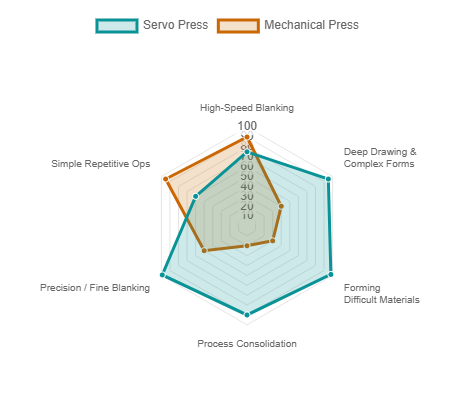How to Choose the Right Mechanical Press for Energy Capacity and Deep Drawing Die?
- Emrah Demirezen

- Nov 13, 2024
- 3 min read
Metal forming and deep drawing can consume a large amount of press energy as longer the drawing distances are required. For example, a mechanical press with a capacity of 50 tons uses 5 kJ energy to form 10 mm, while a deep draw of 30 mm from the same material with the same force requires 15 kJ energy (strain hardening neglected to simplify the example). In addition, the 1.4016 stainless steel materials have a yield strength of 750 MPa, while the material DX53D has a yield strength of 380 MPa. In this case, when the same mold is switched to stainless steel, the press force and therefore the press energy will double.
It is essential for the press manufacturer to provide a table detailing the "press speed in automatic mode," nominal press force, and energy capacity at this stage. Although stamping companies commonly share their press tonnage capacity with toolmakers, they often overlook specifying the energy capacity. Failure to consider the press energy capacity can result in inaccurate press selection, particularly for deep drawing applications.
When comparing different types of presses, it is evident that a mechanical press equipped with intermediate reduction gear boasts a superior energy capacity. This is attributed to the ability to rotate the flywheel at a faster pace, with the energy stored in the flywheel being directly proportional to the square of its angular velocity. In contrast, presses lacking intermediate reduction gears exhibit lower energy capacities as they are limited by slower flywheel speeds.
Mechanical presses designed for deep drawing applications demonstrate enhanced performance with the incorporation of either one or two drive gears, along with single or double gear reductions. The integration of a gear system significantly enhances the torque power of the press. Notably, research indicates that the energy stored in the flywheel increases 4 times as the flywheel speed increases from 75 rpm to 150 rpm, as illustrated in the accompanying graph. This empirical evidence underscores the exceptional strength and efficiency of these presses.
Blue graph shows 150 rev/min gray curve shows 75 rev/min.
X axis (flywheel diameter)
Y axis (flywheel energy)
Y axis-right (flywhell moment of inertia)

Working with higher strength steels compared to mild steels necessitates significantly greater blank holder and punch forces. This leads to elevated friction forces and interface temperatures. If the interface temperature surpasses a critical threshold, issues such as lubrication failure and other forming problems with the die may arise.
While conducting a production run, it is a common practice to decrease press speed in order to reduce process operating temperatures and mitigate heat-related forming issues. Nevertheless, if the press speed falls below a critical threshold, the available energy can diminish rapidly.

Let's examine this situation in the energy capacity graph above;
1) The gray line shows the energy that our motor can transfer to our flywheel per stroke.
2) The red line shows the energy that our flywheel can transfer to the ram and die by a 20% speed decrease.
3) The orange and yellow lines show the energy need per stroke of 2 different dies
If we look at the speed value of 39 strokes/min as an example, die-1 (orange line) will operate without any problems because the flywheel energy capacity is at 32 kJ and the die requires 30 kJ/stroke energy. At the same speed, die-2 (yellow line) will have problems because it requires 36 kJ/stroke energy. In order to operate die-2 properly, the press speed must be increased to 42 strokes/min and above.
Finally, if we had a 3rd die and the energy it needed was 39 kJ/stroke. Regardless of our press speed, when operating in automatic mode, our motor would not be able to provide the required energy to the flywheel, so our flywheel would slow down after each stroke and eventually become inoperable.
Mechanical press, energy capacity, deep drawing
Emrah Demirezen
Metal Forming Specialist - Press Designer



Comments